The best cancer charities driving real change and impact

Chances are, many people at your organization have been touched by cancer in some way. In fact, experts anticipate that about 2 million people will receive a cancer diagnosis in 2025. Fortunately, several cancer charities are actively working to improve patient outcomes, whether through treatments, prevention, or support.
These charities do incredible work, but they require support from the community in the form of donations, volunteer work, or awareness. When you support a cancer organization, you’re directly contributing to increased survival, stronger communities, and hope for the 2 million people who may receive a diagnosis.
Below, we share some of the top cancer charities, the work they’re doing, and how you can get involved.
Top 15 cancer charities overview
There are numerous cancer charities operating today, but they’re not all equal. When evaluating cancer charities, consider looking them up on various cancer watchdog sites like Charity Navigator or GuideStar. These sites compile details about charities to help you understand how they use their money and what sort of impact they make.
Below, we’ve rounded up 15 of the top cancer charities, with details including the type of cancer(s) they support, their program spending, and their average annual revenue from donations.
| Charity Name | Area of Focus | Program Spending | Avg. Annual Donations |
| St. Jude Children’s Research Hospital | Pediatric cancer | $1,861,943 | $32,736 |
| American Cancer Society | All cancers | $663,797 | $262,270 |
| Cancer Research Institute | Immunotherapy for all cancers | $33,346,709 | $24,493,909 |
| Memorial Sloan Kettering Cancer Center | All cancers | Unknown | $334,816 |
| Leukemia & Lymphoma Society | Blood cancers | $300,537 | $268,486 |
| Breast Cancer Research Foundation | Breast cancer and metastatic breast cancer | $76,508,638 | $115,664,096 |
| Pancreatic Cancer Action Network (PanCAN) | Pancreatic cancer | ~$41,237,330 | ~$19,927,418 |
| Prostate Cancer Foundation | Prostate cancer | $45,458,352 | $51,683,892 |
| Prevent Cancer Foundation | Cancer prevention and education | $6,436,784 | $2,232,162 |
| Ovarian Cancer Research Alliance | Ovarian cancer research | $11,511,310 | ~$3,680,624 |
| Susan G. Komen for the Cure | Breast cancer | $105,646,183 | $98,107,413 |
| Damon Runyon Cancer Research Foundation | Innovations for all cancers | ~$18,924,200 | ~$8,458,400 |
| Livestrong Foundation | Cancer survivorship support | $2,489,489 | $1,396,530 |
| National Breast Cancer Foundation | Breast cancer support, education, and early detection | $22,993,024 | $2,516,292 |
| CancerCare | Free cancer support services | $65,755,827 | $7,060,103 |
1. St. Jude Children’s Research Hospital
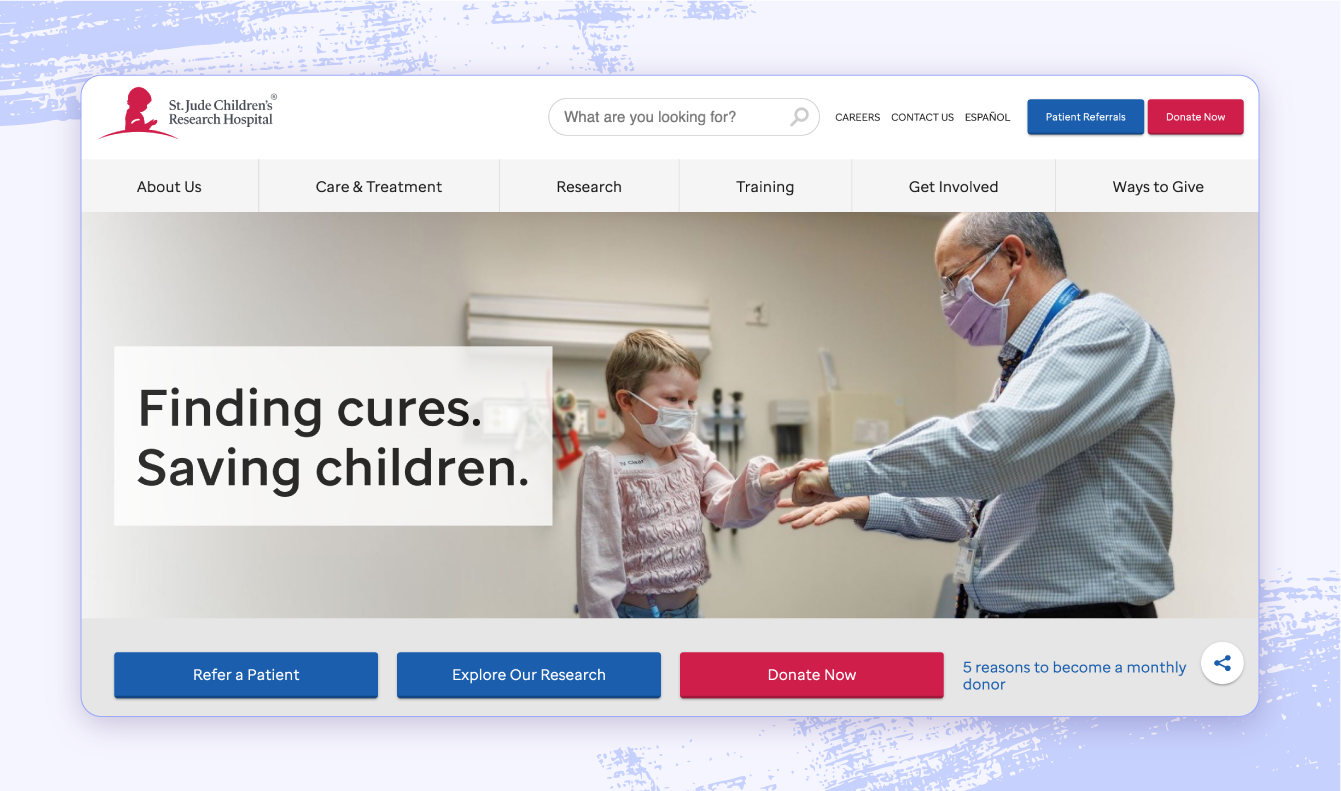
St. Jude Children’s Research Hospital, also referred to simply as “St. Jude,” was founded by Danny Thomas in 1962. Located in Memphis, Tennessee, St. Jude serves to further the prevention and cure of pediatric disease, particularly cancer.
What makes St. Jude especially noteworthy is the organization’s commitment to providing treatment to children at no cost to their families, even without insurance coverage. Plus, most of St. Jude’s funding is from donors, unlike most hospitals.
Key impact stats
St. Jude’s impacts are far-reaching, including:
- Providing specialized training to healthcare workers around the world, enabling them to leverage this knowledge in their home countries
- Sharing research findings with global institutions to save even more lives
- Pushing the childhood cancer survival rate to over 80% thanks to treatments developed at St. Jude
- Achieving a 94% survival rate for acute lymphoblastic leukemia (ALL), which had a survival rate of just 4% in 1962
Why donate
- St. Jude treats over 90 life-threatening childhood diseases.
- Families of children treated at St. Jude never receive a bill or pay a penny, including for the cost of travel, housing, and food.
- By 2030, St. Jude hopes to improve the global survival rates of the six most common pediatric cancers from 20% to 60%.
How to get involved
If you’d like to get your organization involved with St. Jude, you can donate funds in several ways, including one-time donations, monthly giving, and more. You can also start your own internal fundraiser to collect money for St. Jude.
Or, you can leverage your corporate volunteering program and sign up to volunteer with a local office. Opportunities include event support, donor relationship management, office and administrative work, or even virtual opportunities.
2. American Cancer Society
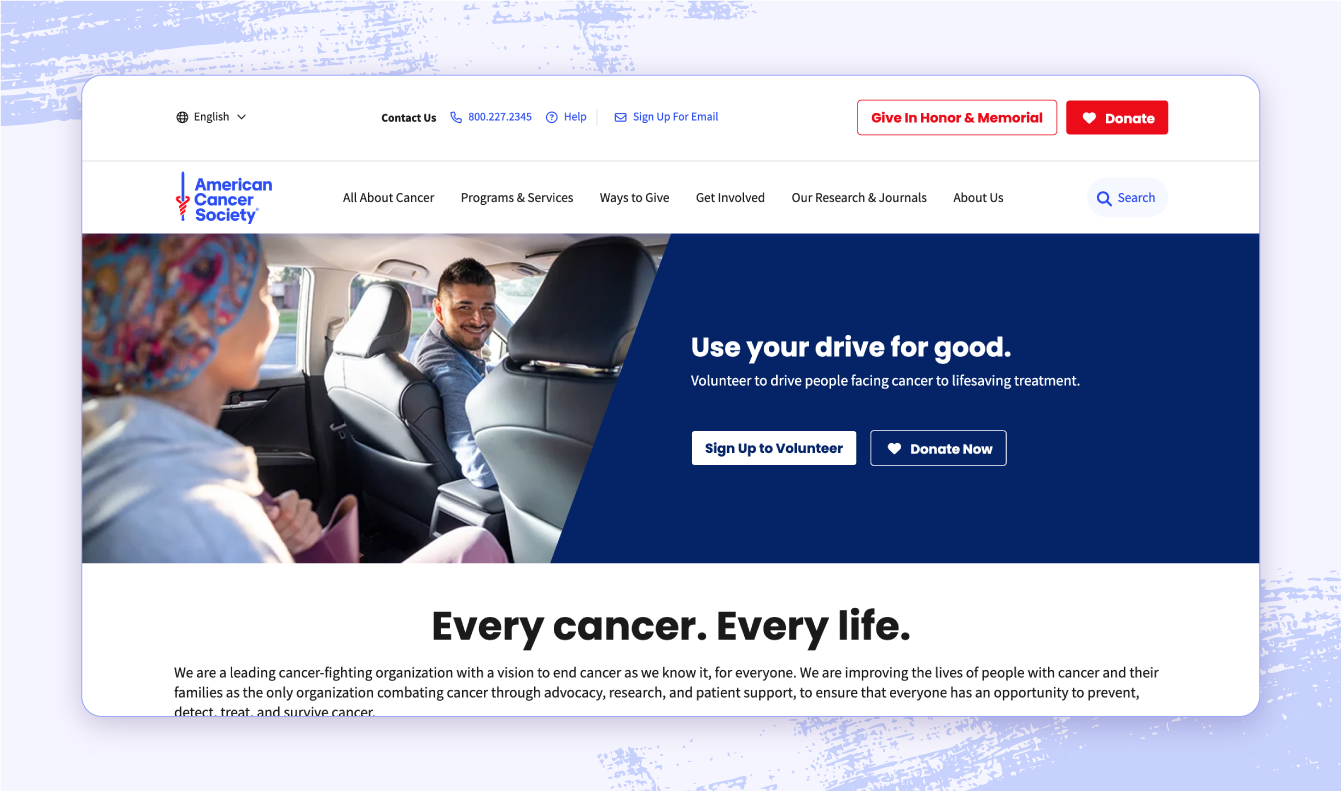
The American Cancer Society has a long and storied history, starting in 1913 when the organization was founded by a team of 15 (10 doctors and five laypeople) in New York City. In 1936, the Women’s Field Army was created to raise funds and educate the community.
To date, researchers funded by the American Cancer Society have contributed to almost every major breakthrough in cancer research since the organization began. Since 1946, they’ve invested over $5 billion in research.
Key impact stats
Key impacts of the American Cancer Society include contributions toward:
- A 33% drop in the United States’ overall death rate from cancer
- A breast cancer survival rate of 91%, up from 75% in the 1970s
- A 97% prostate cancer survival rate, from 68% in the 1970s
Why donate
- The American Cancer Society has invested millions in cancer research, dramatically impacting cancer survival rates.
- The organization also established the Center for Diversity in Cancer Research Training, which serves to further diversity and inclusion in the cancer-related workforce.
How to get involved
There are several ways to get involved with the American Cancer Society. You can create a fundraiser or fundraise on social media; raise funds through youth sports; or join the GenNow Network, made up of emerging young professional leaders.
If you want to get involved and break a sweat, consider participating in DetermiNation, American Cancer Society’s endurance program which includes cycling, hiking, running, and even yoga. Or, join the Relay for Life race or Making Strides Against Breast Cancer walk to help raise money.
3. Cancer Research Institute
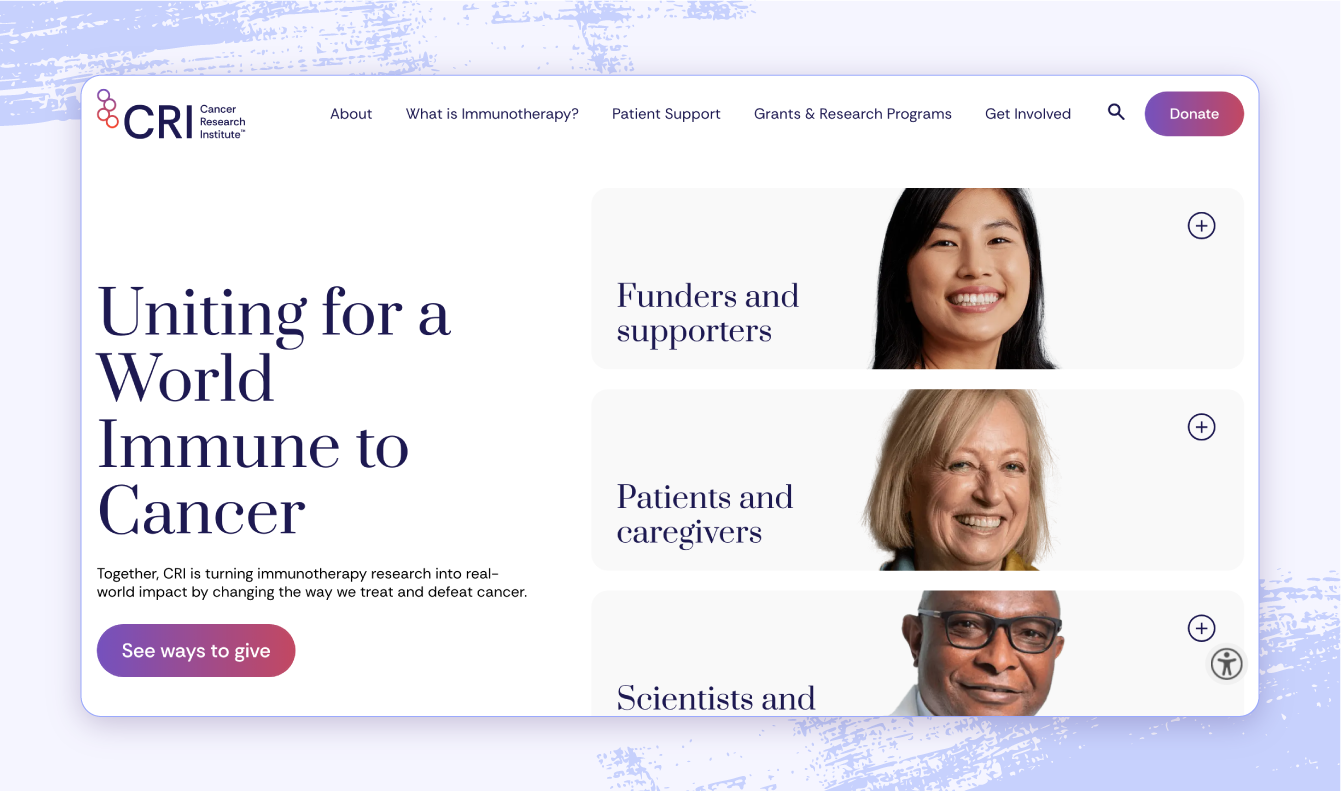
The Cancer Research Institute was formed in 1953 as the first nonprofit organization to further immunotherapy research for cancer. By 1959, a study showed that mice injected with immunotherapy showed a resistance to tumor growth. This specific therapy became the first active immunotherapy approved by the FDA in 1990.
Over time, more therapies and breakthroughs were identified, contributing to a more than 30% decline in the number of people in the US dying from cancer.
Key impact stats
CRI has had a major impact on cancer treatment and survival rates. A few key impacts include:
- Naming 25 new postdoctoral fellows in 2025
- Launching funding programs in data science and bioinformatics to provide knowledge to young scientists
- Contributing to the FDA’s 2024 approval of 17 new immunotherapy agents
Why donate
- Further partnerships with pharmaceutical and biotech companies developing promising immunotherapy options
- Extend the research of disease-specific cancer charities
- Fund science and training of future scientists
- Provide patient and caregiver education about immunotherapy treatment and clinical trials
How to get involved
Individuals can get involved with CRI by participating in clinical trials, or sign up for events like conferences, marathons, or half marathons all around the world. These can work great as team events, too.
You also have the option of several types of fundraising, including direct giving, IRA charitable rollovers, workplace giving, and planned giving.
4. Memorial Sloan Kettering Cancer Center
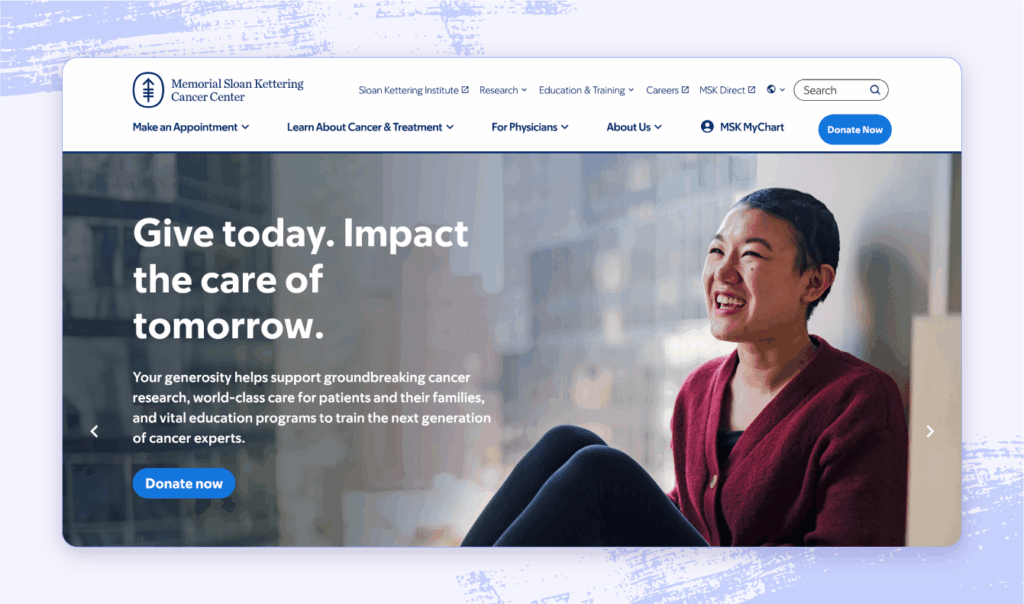
The mission of Memorial Sloan Kettering Cancer Center is to end cancer for life. Founded in 1884, today they have locations throughout New York and New Jersey as well as telehealth options. They’ve been ranked in the top two “Best Hospitals for Cancer” by US News & World Report since 1990 — the year they started rating hospitals.
Key impact stats
MSK has done a lot for the cancer community, with a few standout details from their 2024 annual report:
- In 2024, the US Food and Drug Administration approved 11 drugs thanks to major contributions from MSK researchers.
- MSK advanced new methods to diagnose lung cancer, such as a radiation-free screening and a new imaging technique. Plus, they discovered a distinct subtype of cancer called atypical small cell lung carcinoma.
- MSK’s 1500+ attending physicians and 4,700+ nurses supported over 26,000 admissions and 1 million outpatient visits in 2024.
Why donate
- Patients come to MSK from more than 70 countries around the world.
- Donations contribute toward furthering future cancer vaccines.
- MSK continues to work on precision diagnostics that help discover cancer earlier and more specifically, leading to more targeted treatments.
How to get involved
Get involved with MSK and you’ll be in good company — in 2024, 370,000 donors gave to the organization across 84 countries. You can donate money or raise funds in all the usual ways, or you can attend fundraising events ranging from comedy shows to indoor cycling competitions to races.
You can also join the MSK Campaign, with which the organization hopes to raise $6 billion by 2030. Already, they’ve raised $3.5 billion, launched over 1,700 clinical trials, achieved over 30 FDA approvals, and funded 52 fellowships.
5. Leukemia & Lymphoma Society
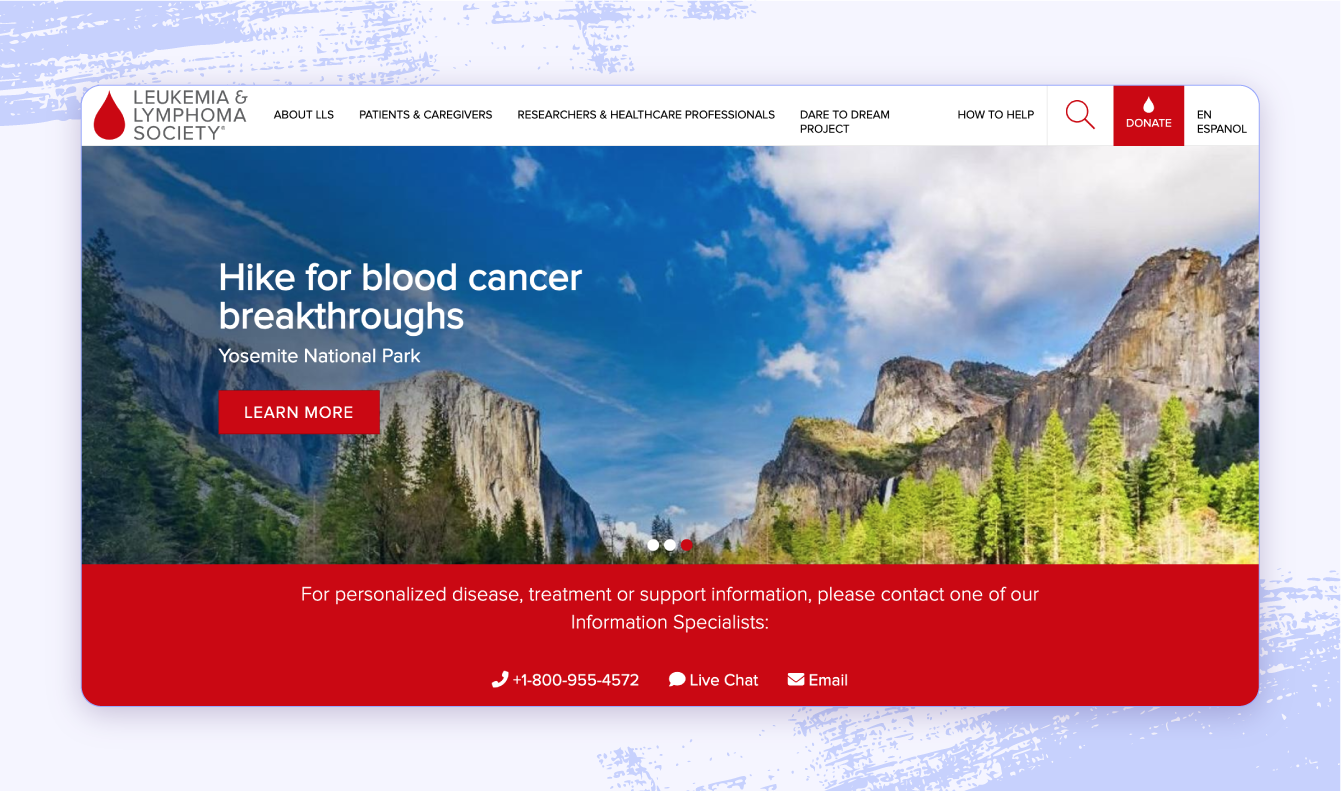
The Leukemia & Lymphoma Society (LLS) transformed tragedy into triumph over blood cancers. In 1949, five years after Rudolph and Antoinette de Villiers lost their son Robbie to leukemia, they began the Robert Roesler de Villiers Foundation in New York City.
Since then, they’ve invested almost $1.8 million in research and treatment of blood cancers, including leukemia, lymphoma, and myeloma. In addition, they offer extensive support to those affected by cancer, including peer support, financial assistance, nutrition counseling, scholarship funds, and more.
Key impact stats
Since its inception, LLS has achieved meaningful impacts, including:
- LLS has helped advance 70% of FDA-approved blood cancer treatment options since 2017.
- With a network of over 100,000 volunteers, LLS advocates for state and federal policies to increase access to care.
- Since 2007, LLS’s Co-Pay Assistance Program has given $240 million to over 55,000 patients.
Why donate
- LLS is the leading source of free information, support, and education about blood cancer.
- LLS is also the largest nonprofit funder of blood cancer research.
- Funds go toward innovative research, grants for studies and clinical trials, and LLS’s strategic philanthropy arm.
How to get involved
Community support is available to those who need it — in the form of podcasts, online chat, support groups, and individual peer support — and your team can volunteer to provide that support as well. You can also submit a story about how LLS has impacted your life or the life of a loved one.
You can get involved with LLS by participating in fundraising events, creating a tribute page in honor or memory of a loved one, or creating your own fundraiser. Additional volunteer opportunities, including volunteer internships, vary by region.
6. Breast Cancer Research Foundation
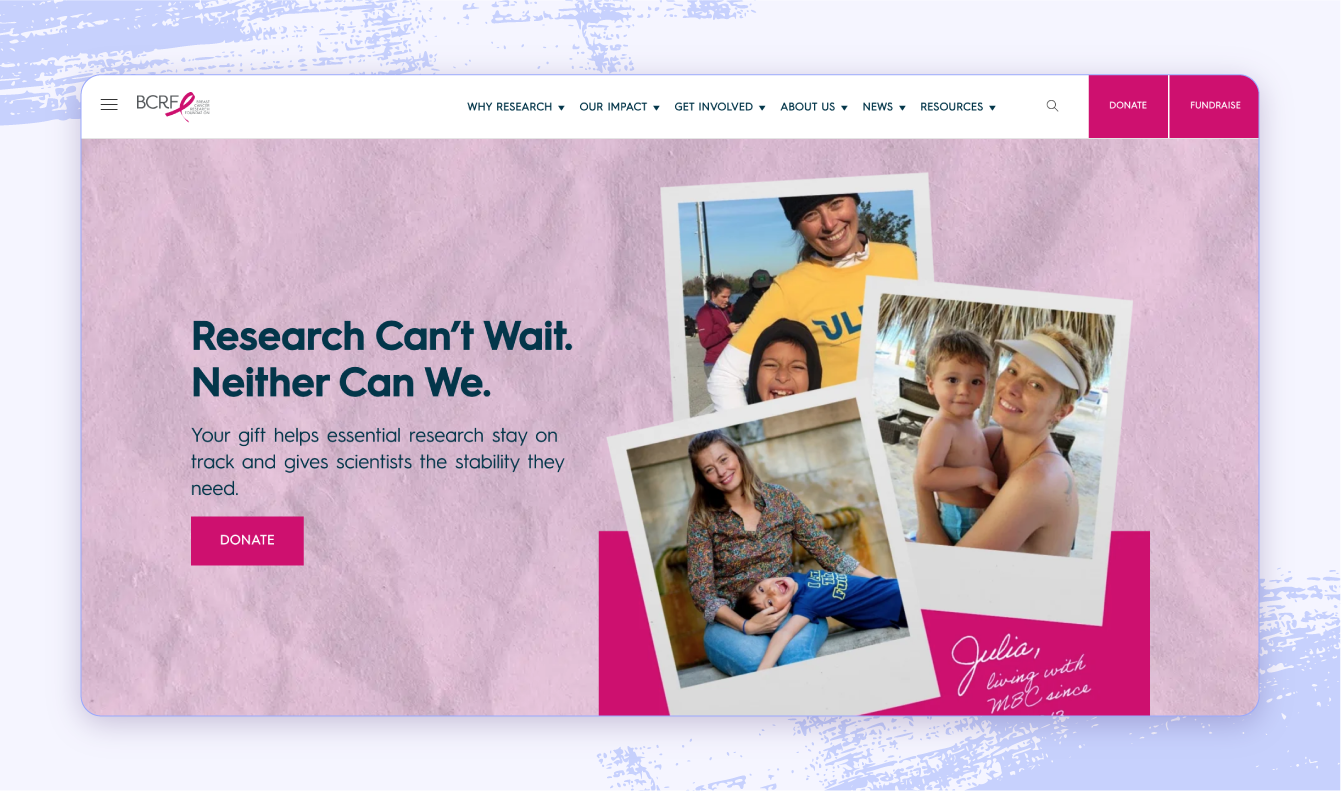
The Breast Cancer Research Foundation (BCRF) began in 1993, founded by Evelyn Lauder, her husband Leonard, and Dr. Larry Norton. (Of note, Mrs. Lauder is also the creator of the pink ribbon commonly associated with breast cancer today. )
After her own experience with breast cancer, Evelyn Lauder used that experience for positive action, contributing to the breast center at Memorial Sloan Kettering in 1989.
In starting BCRF, the goal was to fund research to cure breast cancer. Today, their areas of focus include heredity and ethnicity, lifestyle and cancer prevention, metastasis, survivorship, treatment, and tumor biology.
Key impact stats
Since its inception, BCRF has had a major impact on breast cancer research. Noteworthy statistics include:
- BCRF supports over 260 researchers throughout the globe.
- The discoverers of both BRCA gene mutations — which lead to hereditary breast cancer — were BCRF grantees.
- Treatments like Herceptin and Tamoxifen were developed with support from BCRF.
Why donate
- BCRF is the highest-rated breast cancer-related organization in the US.
- BCRF is also the United States’ largest private funder of both metastatic breast cancer research and breast cancer research in general.
How to get involved
While BCRF is small and doesn’t have local chapters to get involved with, you can attend events held in several cities. You can also start your own fundraiser, make a planned gift, or simply donate directly.
For an easy way to give back, you can Shop Pink by purchasing products from organizations that partner with BCRF. And if you play video games, you can stream to raise funds with Game for BCRF.
7. Pancreatic Cancer Action Network (PanCAN)
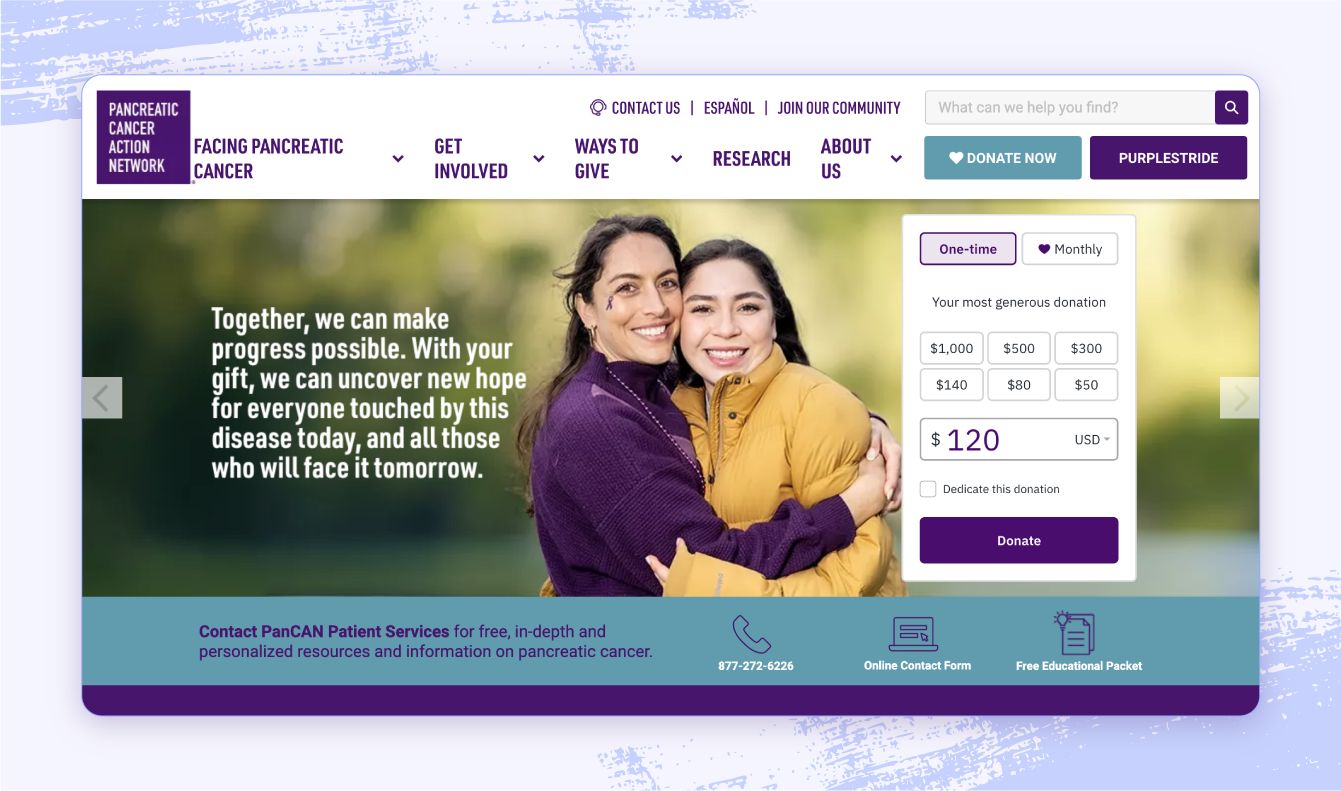
The Pancreatic Cancer Action Network (PanCAN) envisions a world where patients can thrive with pancreatic cancer. Their mission is to take action to improve the lives of everyone affected by pancreatic cancer, through research, community building, knowledge sharing, and advocacy.
Founded in 1999, PanCAN has now granted a research investment of $208 million and boosted pancreatic cancer funding by a whopping 1,075%.
Key impact stats
PanCAN conducts independent research and awards grants to scientists working to transform the way pancreatic cancer is diagnosed and treated. A few of their impacts include:
- PanCAN has tested 1,755 tumors through its Know Your Tumor service and collected disease information from 1,991 patients.
- Recently, PanCAN announced a partnership with Acurion to leverage patient data and AI to accelerate diagnoses of pancreatic cancer.
- In 2020, Lancet Oncology, a medical journal, published data showing that PanCAN’s Know Your Tumor service can help patients live longer.
Why donate
- PanCAN brings together experts and leaders throughout the country to improve the way we detect and treat pancreatic cancer.
- PanCAN awards grants for pancreatic cancer research — basic, translational, and clinical — and has awarded 236 grants since 2003.
- Funds raised go toward programs like Know Your Tumor, Early Detection Initiative, the Precision Promise clinical trial, and more.
How to get involved
Take steps toward ending pancreatic cancer with the PanCAN PurpleStride walk and run events, or host your own endurance event to raise funds for the cause. You can also find local volunteer and advocacy opportunities to help further the fight against pancreatic cancer via community service projects.
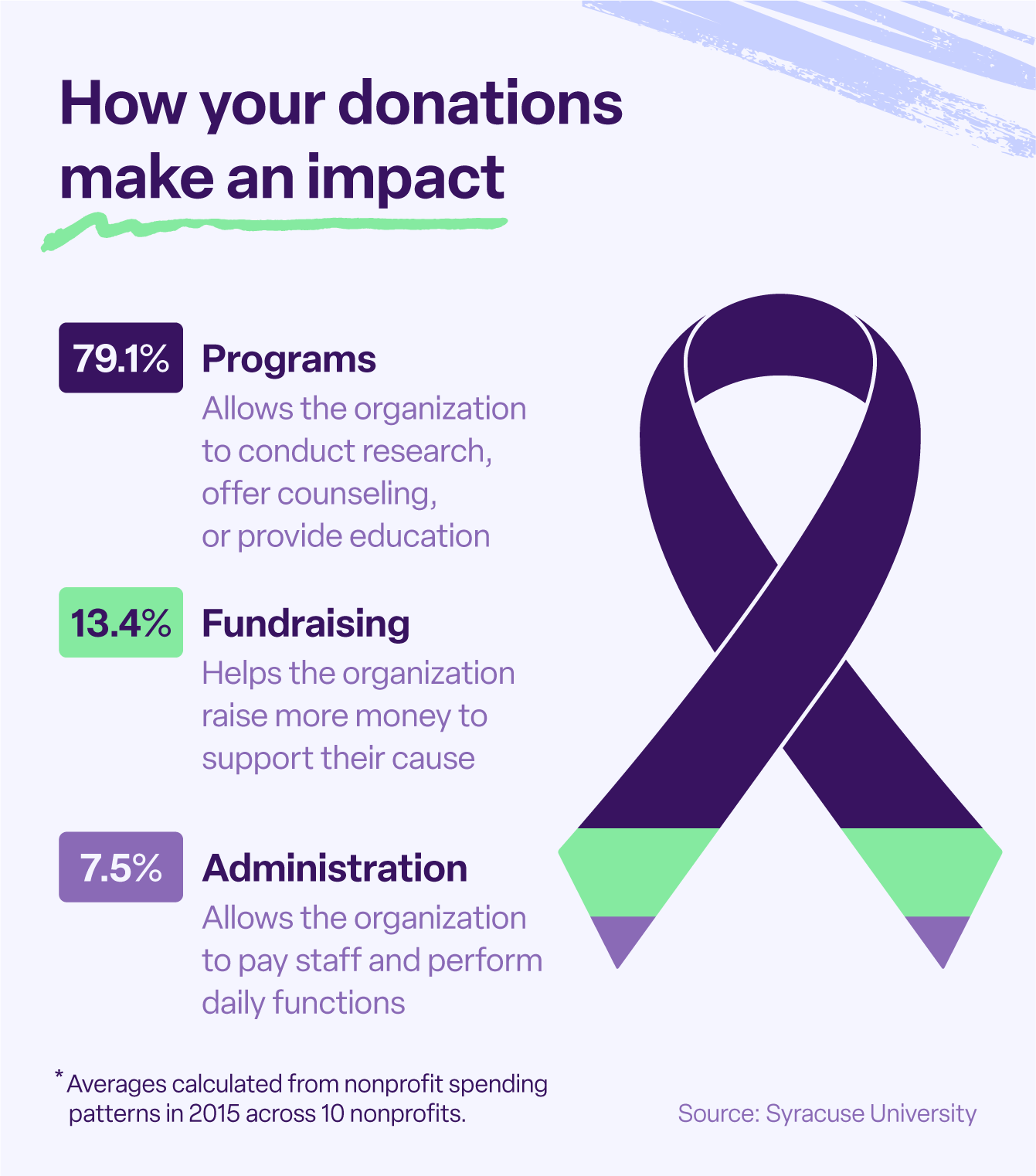
8. Prostate Cancer Foundation
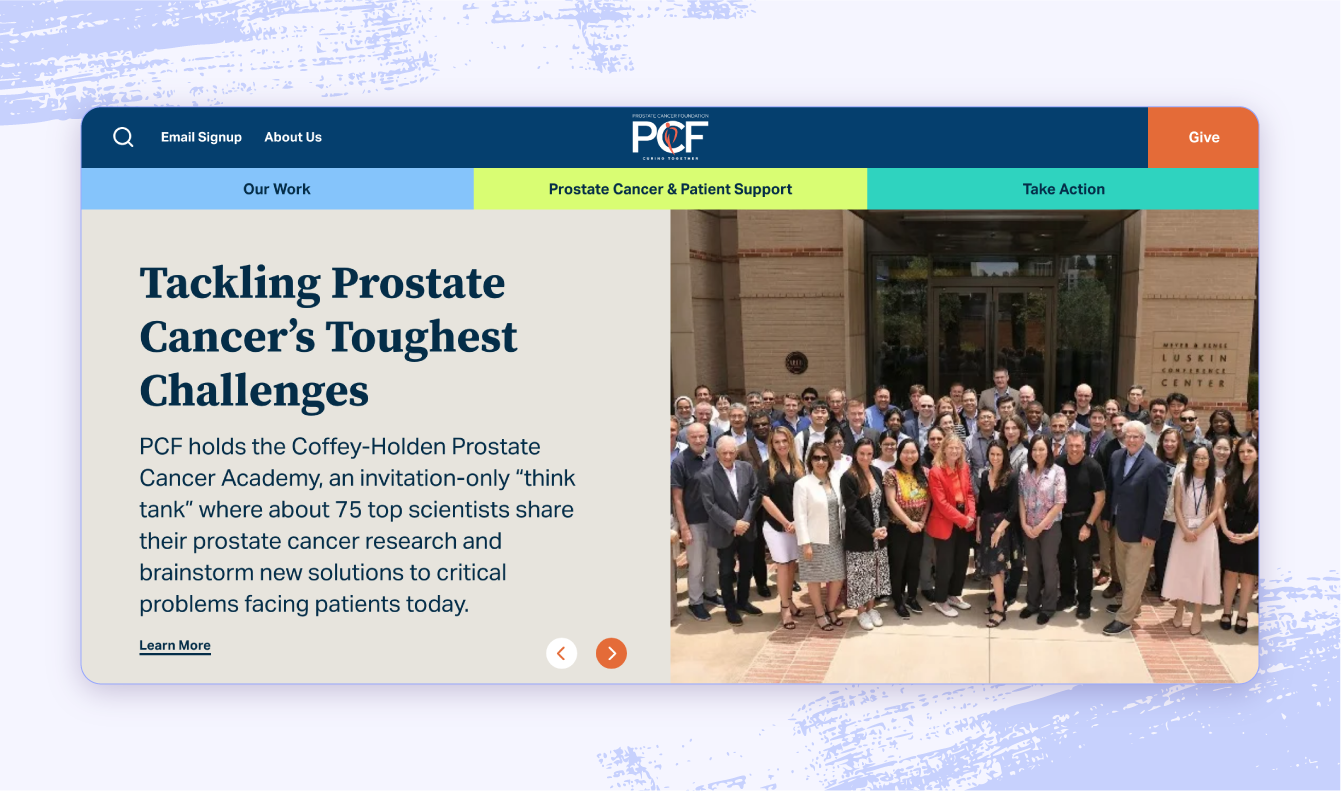
Mike Milken, who had already been involved with cancer research via his family’s foundation, received a prostate cancer diagnosis in 1993. This spurred him to begin the Prostate Cancer Foundation.
At the time, prostate cancer was underfunded, and Milken set out on a mission to further research, simplify the grant process, and advance the understanding of prostate cancer. Today, PCF works by investing in three areas: people, community, and science.
Key impact stats
When PCF was founded, there was an existing screening test, but it was new to the market. Only three treatments for advanced disease existed, and a diagnosis of metastatic prostate cancer carried poor odds. Since then, PCF has made major impacts:
- It’s estimated that 1.5 million more men are living today due to research and innovation funded by PCF.
- PCF has awarded funds to over 2,250 projects, including clinical research into treatments, drugs, and the biology of prostate cancer.
- PCF has contributed to a 20-fold growth in government funding for prostate cancer.
Why donate
- PCF funds research into the biology and treatment of prostate cancer, discovering therapies and other ways to improve survival rates and quality of life.
- Challenge Awards support investigators addressing key research challenges, providing $300,000 to $1.5 million a year across three years.
- PCF Therapy Acceleration to Intercept Cancer Lethality (TACTICAL) Awards give up to $10 million (over three years) to large-scale research projects.
How to get involved
There are plenty of ways to get involved with PCF. Attend events like the Cruisin’ for the Cure Benefit Show in Reno or the Pocono Raceway Testing Event. Consider hosting a golf tournament to raise funds or simply set up a fundraiser or donate directly.
9. Prevent Cancer Foundation
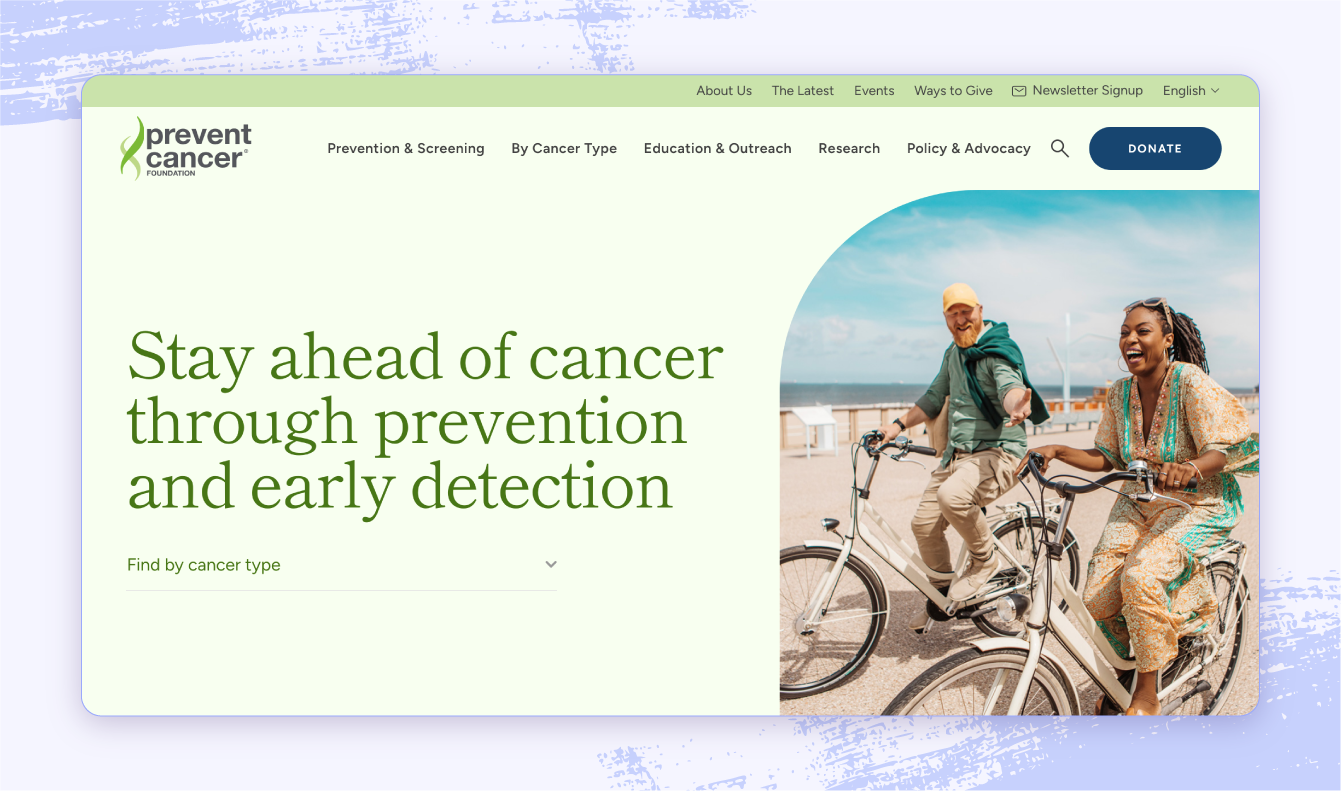
The Prevent Cancer Foundation hopes to take power away from cancer and put it back in the people’s hands. They envision a world where cancer is detected, survived, and more importantly, prevented. The organization was founded in 1985 and has four clear focus areas: research, education, outreach, and advocacy. Their goal is to reduce cancer deaths by 40% by 2035, and they plan to do this by funding research and expanding access to cancer screening and education.
Key impact stats
As they work toward their goal of slashing cancer deaths by 40%, Prevent Cancer Foundation is already making a steady impact:
- April 2024 was the first National Cancer Prevention and Early Detection Month, advocacy for which was led by the Foundation.
- Over 300 organizations signed in support of the Medicare Multi-Cancer Early Detection Screening Coverage Act of 2021, led by the Foundation.
- In 2011, the Foundation had already invested $130 million in its focus areas.
Why donate
- They’re the only US-based nonprofit solely focused on early detection and prevention of cancer.
- You’ll help fund education to help people take their health into their own hands.
- Advocacy efforts focus on enacting laws that support research and prevention.
How to get involved
If you’re hoping to give money, there are plenty of options: create a fundraiser, dedicate a gift in memory or honor of a loved one, set up monthly gifts, or even donate stock or mutual funds. Alternatively, you can set up your own fundraiser online or in person.
To make a big impact on your friends, family, and community, consider simply sharing the Foundation’s resources. You’ll spread the word about their work while providing education to loved ones about how to prevent or detect cancer.
10. Ovarian Cancer Research Alliance
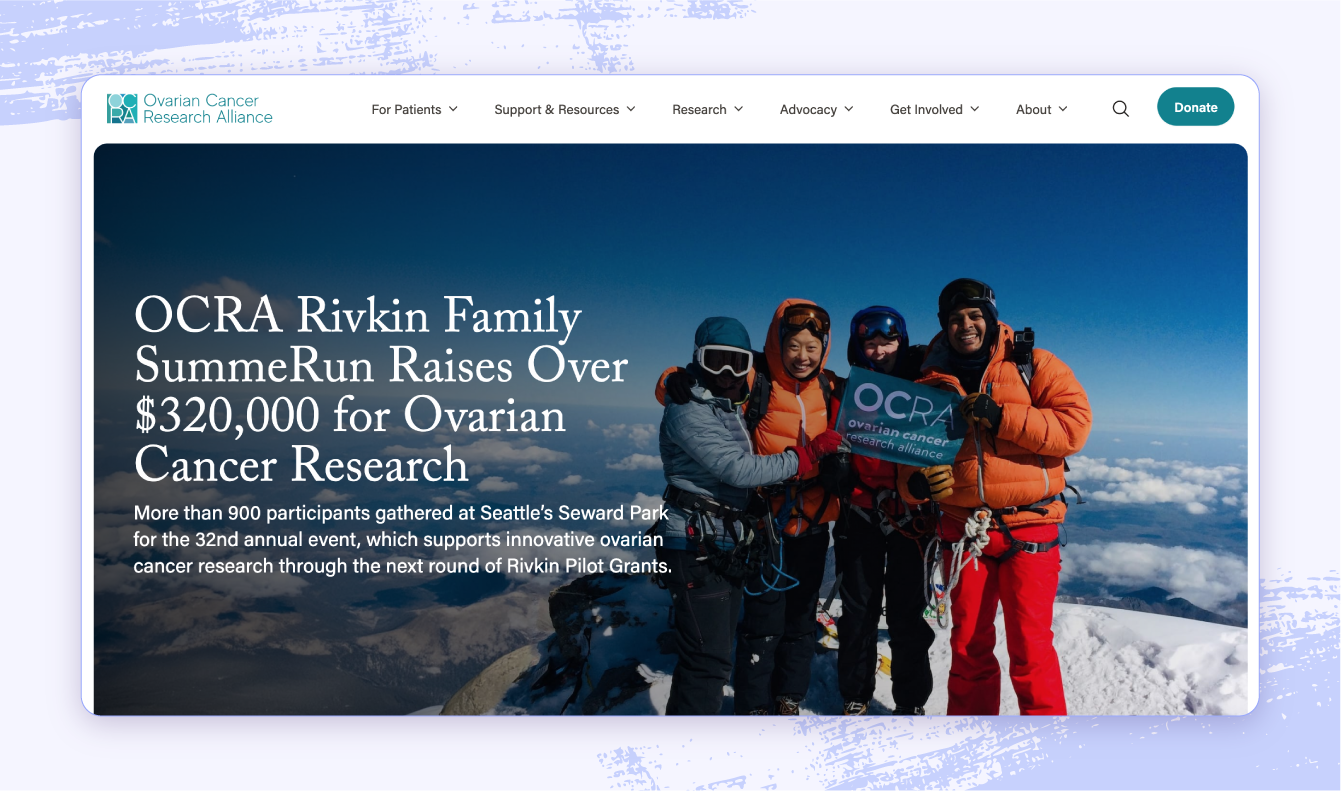
Ovarian Cancer Research Alliance (OCRA) serves to fight ovarian cancer — and all other gynecologic cancers — while providing patient and family support. Blending support and research, OCRA has developed innovative education and advocacy programs, recommended prevention strategies, and invested $128 million in science.
Key impact stats
In addition to their investment in scientific breakthroughs, OCRA has made several other major impacts on people affected by ovarian cancer:
- They’ve helped secure $3.8 billion in federal research and education funding.
- OCRA’s Woman to Woman Peer Mentor Program is available in more than 20 hospitals in the US as well as virtually.
- Survivors Teaching Students lets cancer survivors and caregivers share stories with medical students at over 350 schools.
- Between all of their programs, they support 95,000 individuals annually.
Why donate
- OCRA’s patient support programs are staffed by experienced social workers and offer dedicated support and assistance.
- OCRA states that it invests more funds into ovarian cancer research than any other public charity.
- OCRA is also the only dedicated organization advocating to the government for gynecological cancer funding and policies.
How to get involved
To make your own impact on ovarian and gynecological cancer, you could become a monthly donor, hold a fundraiser, or sponsor a scientist. This may involve advocating to legislators, serving as a peer mentor, or speaking to healthcare students. Or join an event like OCRA’s Rivkin Family SummerRun, an annual race held in Seattle.
11. Susan G. Komen for the Cure

Susan G. Komen for the Cure is one of the best-known cancer charities, envisioning a world without breast cancer. Named for Susan G. Komen, who passed away from breast cancer at 36, the foundation was founded in 1982 by Susan’s sister, Nancy Brinker (who later experienced breast cancer herself). Today, the organization invests in research, support, education, and advocacy.
Key impact stats
- The organization has invested close to $1.1 billion in breast cancer research.
- They’ve also invested almost $2.5 billion into programs for advocacy, education, and support services.
- Policy changes led by Komen have financially helped 114 million people.
Why donate
- Komen’s Patient Care Center has served almost 144,000 people since launching in 2021.
- Komen has contributed funding to 29 new cancer drugs.
- They also focus on financial assistance for patients who need it.
How to get involved
Susan G. Komen for the Cure is probably best known for its annual race, Race for the Cure, held in cities around the world for the past 25 years. Participants can run, walk, and raise funds individually or on a team. They also hold the MORE THAN PINK Walk and Susan G. Komen 3-Day, which is a 60-mile fundraising walk.
Of course, you also have the standard ways to give — direct giving, setting up a fundraiser, and planned giving — as well as volunteer opportunities on local community boards and committees, serving as a policy advocate, or offering peer support.
12. Damon Runyon Cancer Research Foundation
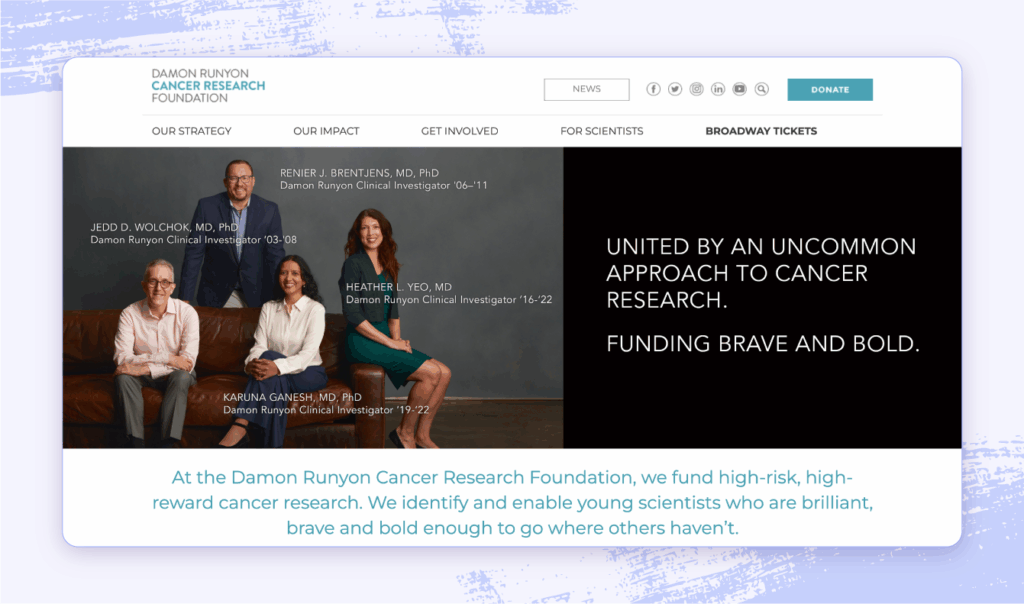
The Damon Runyon Cancer Research Foundation is named for Damon Runyon, a sportswriter and journalist whose story is told in the Broadway musical Guys and Dolls.
After Runyon’s death from throat cancer in 1946, his friend Walter Winchell sourced donations from Americans to fight cancer. This turned into the foundation, which today has invested almost $450 million into cancer research.
Their focus is to award funds to the areas that may have the biggest impact on cancer research, as well as filling in gaps in research funding and specifically investing in emerging scientists. In doing so, they strive to prevent and cure all types of cancer.
Key impact stats
- To date, 13 Damon Runyon scientists have earned a Nobel Prize.
- Damon Runyon scientists contributed to the development of tools like CRISPR Cas9 (which edits the genome).
- Damon Runyon scientists are focused on discovering and developing new approaches. They provided the link between smoking and cancer, used immunotherapy to cure a patient with Stage IV melanoma, and founded major biotech companies.
Why donate
- 100% of donations go toward cancer research, as the organization’s overhead is covered by their endowment and Damon Runyon Broadway Tickets.
- They focus on all types of cancer, rather than limiting to a single focus area.
How to get involved
Donate to the Damon Runyon Cancer Research Foundation directly, via workplace giving or matching gifts, or in honor or memory of a loved one. Alternatively, you can sponsor a scientist, choosing who you support based on their area of focus or the type of cancer they study.
The organization also has a partnership with Broadway theatres, with the price of each ticket sold including a donation to the foundation.
13. Livestrong Foundation
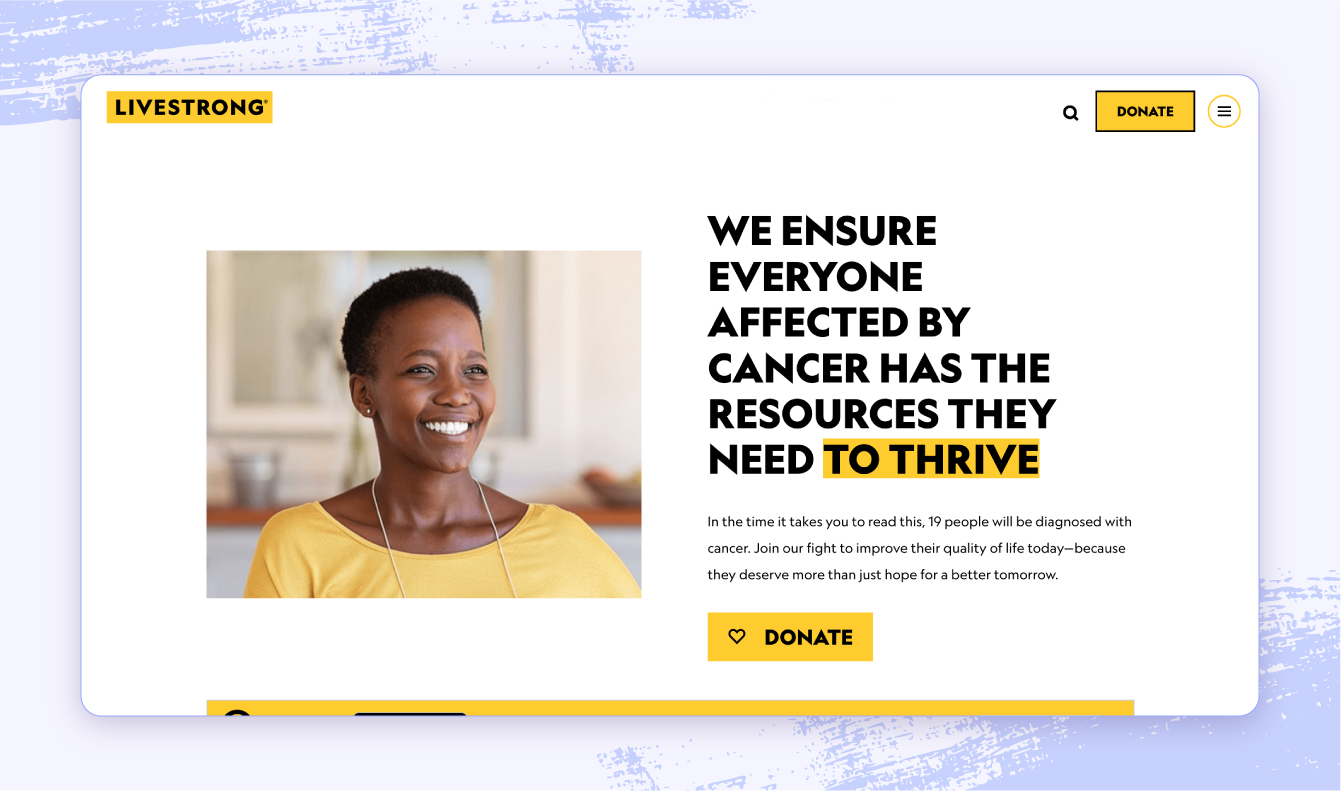
In the early 2000s, you couldn’t go anywhere without seeing the ubiquitous yellow Livestrong bracelet adorning wrists. The Livestrong Foundation, however, had already been working to increase survivorship for years after its founding in 1997 by Lance Armstrong, a professional cyclist who was diagnosed with testicular cancer.
Today, the Livestrong Foundation focuses on exercise oncology, survivorship among young adults and adolescents, and nutrition.
Key impact stats
- Livestrong has provided funds to over 600 partners and programs supporting cancer survivors.
- They’ve supported 19,000 survivors on their post-cancer fertility journeys, saving them over $107 million.
Why donate
- Livestrong offers a Solution Grants program to fund innovations addressing often-overlooked issues.
- You’ll support survivors and caregivers, sometimes overlooked by prevention- and treatment-focused organizations.
How to get involved
You can get involved with Livestrong by creating a fundraiser; joining a run, walk, or cycling event; or becoming a Livestrong Leader in your community. There are also opportunities to join in advocacy efforts to increase government funding for research, care, and treatment.
14. National Breast Cancer Foundation
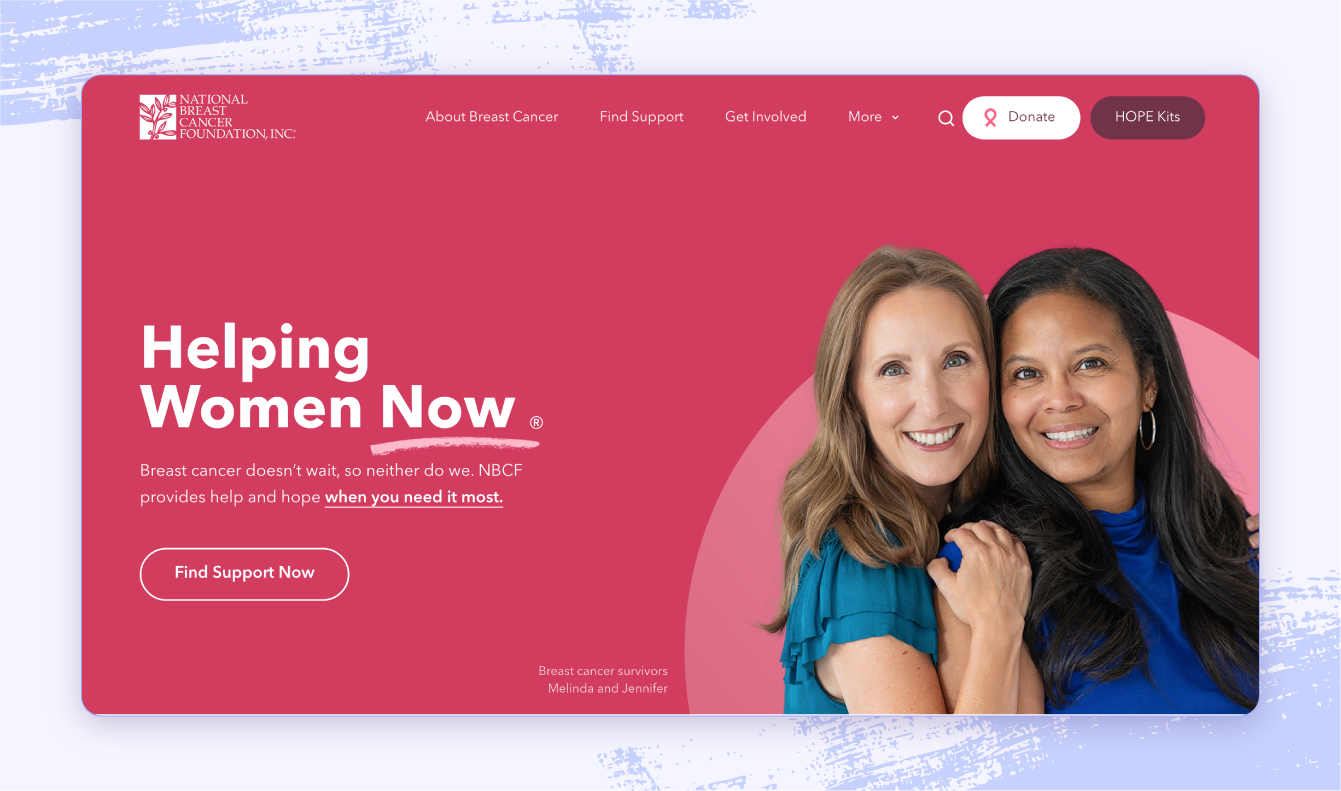
The National Breast Cancer Foundation provides breast cancer education and access to mammography. It was founded in 1991 by Janelle Hail, a breast cancer survivor. After experiencing cancer at a time with little cancer-related information and support, she decided to help others. Now, NBCF offers support services, education, and access to early detection.
Key impact stats
- In the last decade, NBCF has provided more than 192,000 mammograms.
- They’ve also offered more than 858,000 patient navigation services to help those experiencing cancer.
- On the education front, they’ve provided more than 240,000 breast health education services to those in need.
Why donate
- NBCF provides free programs so no one has to face breast cancer on their own.
- 80% of expenses go directly to their programs, earning NBCF the highest Charity Navigator rating.
- NBCF provides free mammograms to underserved communities.
How to get involved
Get involved with NBCF by making a donation (just $150 provides a mammogram), starting a fundraiser, or becoming a community ambassador. Community ambassadors undergo training about breast health, then work closely with staff to raise awareness and funds in the community.
15. CancerCare
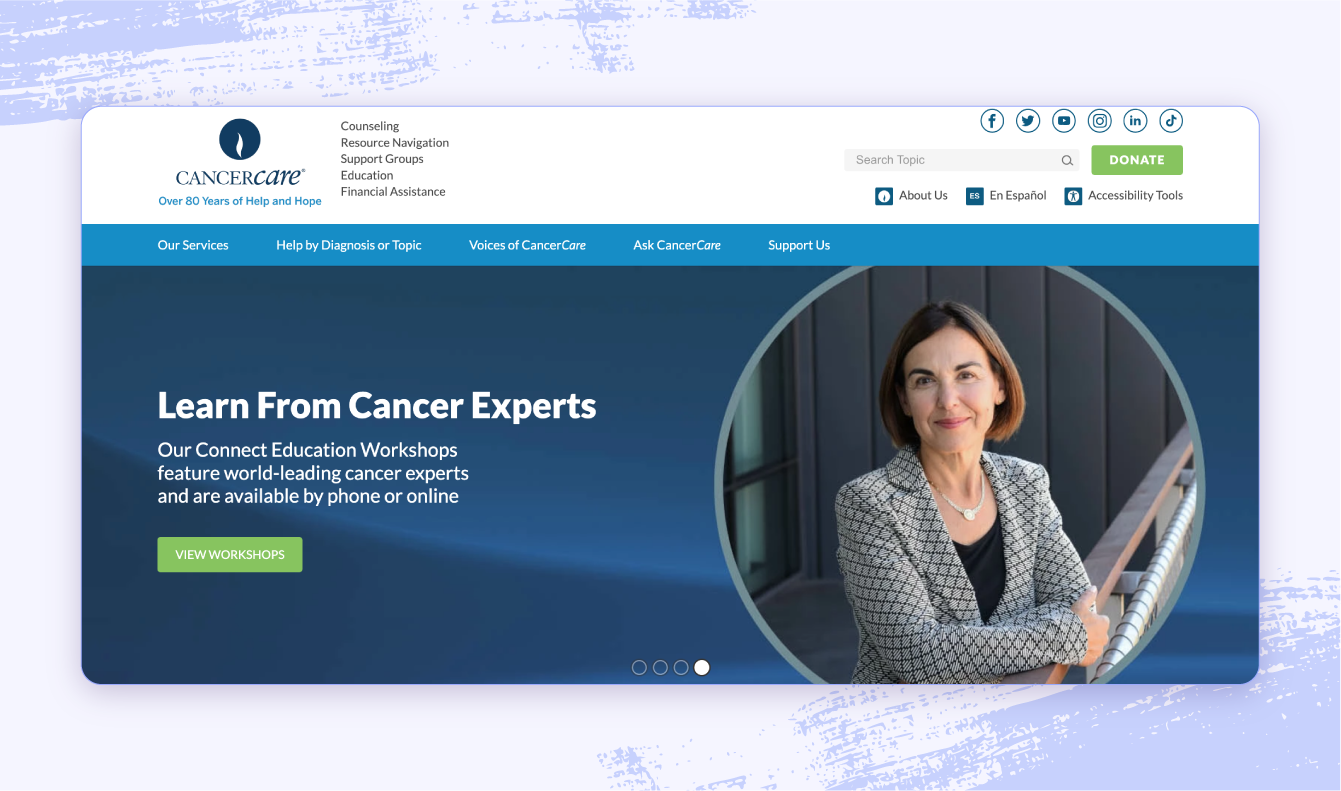
CancerCare provides free support — emotional, financial, and practical — to individuals impacted by cancer. This includes counseling, resource navigation, support groups, education, and financial assistance for treatment or treatment-related costs.
The organization was founded in 1944 and has spent decades leveraging oncological social workers and experts to ensure no one faces cancer alone.
Key impact stats
- In the 2024 fiscal year, CancerCare provided 163,917 services.
- They also gave financial assistance to 25,246 individuals.
- Their Pet Assistance & Wellness Program enabled 991 clients to keep their pet home with them throughout cancer treatment.
Why donate
- Support free, expert-led counseling and support for both patients and families
- Enable access to treatment for families in need
How to get involved
In addition to typical giving, you can get involved with CancerCare by attending their biggest fundraiser events, Walk/Run for Hope, or one of the many other galas and golf tournaments they hold. Young professionals can also join the CancerCare Young Professionals Committee, a group of volunteers supporting the organization’s efforts.
Ways to support beyond donating
While donations are a major part of how these charities stay afloat, there are so many more ways to make a difference.
For starters, organizations can consider raising funds as a team. You could set up a peer-to-peer campaign, hold a fundraiser for a special occasion, or host an event.
Other ways to give include corporate giving or donation matching — consider offering a matching program — or encourage members of your organization to engage in planned or legacy giving.
If you would rather be hands-on, volunteering has plenty of benefits for everyone; most nonprofits are thrilled to bring on new volunteers who believe in the mission.
Another way to be hands-on and get some exercise, too, is to participate in events like runs, walks, or rides. If you’re looking to coordinate group volunteering, consider leveraging an all-in-one volunteer management software.
Take the next step toward impactful giving with Bonterra
It can be scary to think about cancer, but it’s inspiring to see how many organizations are offering support and striving for a cure. Supporting these cancer charities is one of the best ways to give back and provide hope to those impacted by cancer.
Just like your organization, each of these has a lot going on behind the scenes — managing volunteers, raising money, and reporting on their impact, to name just a few challenges.
That’s where a tool like Bonterra can help. Bonterra helps purpose-driven organizations drive their fundraising and volunteer management efforts further and keep them streamlined. Organizations can focus on making a difference and stamping out cancer, rather than getting lost in administrative work.
Interested in seeing how Bonterra can power your organization with its powerful medical affairs platform? Get started today and learn more.

FAQ
What are the best cancer charities?
The best cancer charities are those that are mission-driven, transparent, and effective. A few that earn high ratings and do impactful work include the Leukemia & Lymphoma Society, the Breast Cancer Research Foundation, and PanCAN.
Which cancer charity should you donate to?
When looking for cancer charities to donate to, choose one whose mission resonates with you. This may be because you or a loved one has experience with a certain type of cancer or because you have a desire to support research, education, or advocacy.
What organizations help with cancer?
There are several organizations that assist those with cancer, including CancerCare, which offers emotional and financial support; Livestrong, which supports survivorship; and the National Breast Cancer Foundation, which provides education and access to early detection.
Why should you donate to cancer research?
Donating to cancer research can drive the discovery of new treatments, medications, and even cures, and will directly impact the lives of millions of people affected by cancer.
Work with Bonterra



